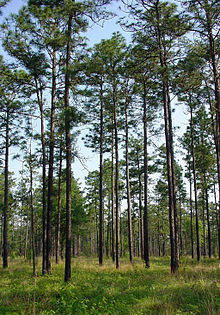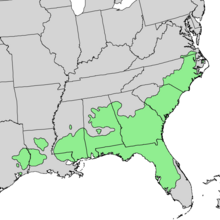Long leaf pine
| Longleaf pine | |
|---|---|
 |
|
| Longleaf pine (Pinus palustris) forest | |
| Scientific classification | |
| Kingdom: | Plantae |
| Division: | Pinophyta |
| Class: | Pinopsida |
| Order: | Pinales |
| Family: | Pinaceae |
| Genus: | Pinus |
| Subgenus: | Pinus |
| Species: | P. palustris |
| Binomial name | |
|
Pinus palustris Mill. |
|
 |
|
Pinus palustris, commonly known as the longleaf pine, is a pine native to the southeastern United States, found along the coastal plain from eastern Texas to southeast Virginia, extending into northern and central Florida. It reaches a height of 30–35 m (98–115 ft) and a diameter of 0.7 m (28 in). In the past, they reportedly grew to 47 m (154 ft) with a diameter of 1.2 m (47 in).
The bark is thick, reddish-brown, and scaly. The leaves are dark green and needle-like, and occur in bundles of three. They often are twisted and 20–45 cm (7.9–17.7 in) in length. It is one of the two southeastern U.S. pines with long needles, the other being slash pine.
The cones, both female seed cones (ovulate strobili) and male pollen cones (staminate strobili), are initiated during the growing season before buds emerge. Pollen cones begin forming in their buds in July, while seed conelets are formed during a relatively short period of time in August. Pollination occurs early the following spring, with the male cones 3–8 cm (1.2–3.1 in) long. The female (seed) cones mature in about twenty months from pollination; when mature they are yellow-brown in color, 15–25 cm (5.9–9.8 in) long, and 5–7 cm (2.0–2.8 in) broad, opening to 12 cm (4.7 in), and have a small, but sharp, downward-pointing spine on the middle of each scale. The seeds are 7–9 mm (0.28–0.35 in) long, with a 25–40 mm (0.98–1.57 in) wing.
Longleaf pine takes 100 to 150 years to become full size and may live to be 500 years old. When young, they grow a long taproot, which usually is 2–3 m (6.6–9.8 ft) long; by maturity they have a wide spreading lateral root system with several deep 'sinker' roots. It grows on well-drained, usually sandy soil, often in pure stands. In northern Alabama, it sometimes occurs on clay soil. The scientific name meaning, "of marshes," is a misunderstanding on the part of Philip Miller who described the species, after seeing longleaf pine forests with temporary winter flooding.
...
Wikipedia

